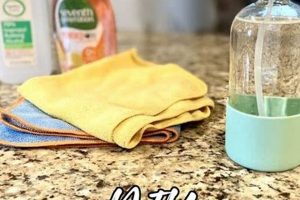The creation of flour suitable for bread making through methods accessible to home cooks, often involving the modification or combination of readily available flours, is a common practice. This allows individuals to tailor their flour composition to specific recipes or nutritional needs. For instance, combining all-purpose flour with vital wheat gluten can approximate the protein content of commercially produced bread flour.
Engaging in this practice offers several advantages. It provides control over the ingredients, potentially leading to healthier bread options or catering to dietary restrictions. It can also represent a cost-effective alternative to purchasing specialized flours, particularly in regions where these are less readily available or more expensive. Historically, home milling and blending of flours were essential skills, predating the widespread availability of standardized commercial products.
The following sections will delve into the specific techniques for achieving desired flour characteristics, exploring different flour combinations, and considering the impact of these choices on the final baked product.
Tips for Creating Bread Flour at Home
Achieving optimal results when making bread relies heavily on the flour’s gluten content. By understanding the properties of various flours and employing precise mixing techniques, satisfactory homemade bread flour alternatives can be created.
Tip 1: Understand Protein Content: The key to successful bread making lies in a flour’s protein content, typically ranging between 12-14% for bread flour. This protein forms gluten, which provides structure and elasticity to the dough. Check the nutritional information label to determine the protein percentage of your base flour.
Tip 2: Fortify All-Purpose Flour with Vital Wheat Gluten: All-purpose flour generally contains a lower protein content than bread flour. Supplementing it with vital wheat gluten is a common method to increase the protein percentage. A general guideline is to add approximately 1-2 tablespoons of vital wheat gluten per cup of all-purpose flour. Adjust based on the desired dough consistency.
Tip 3: Experiment with Whole Wheat Flour Blends: While whole wheat flour adds nutritional value and flavor, it can also result in a denser loaf. To mitigate this, blend whole wheat flour with all-purpose flour, adjusting the ratio to achieve the desired texture. Start with a 1:3 ratio of whole wheat to all-purpose flour and experiment from there.
Tip 4: Account for Hydration Levels: Flours absorb water differently. Whole wheat flour, for example, typically requires more hydration than all-purpose flour. When substituting or blending flours, be prepared to adjust the liquid content in the recipe to achieve the proper dough consistency. Add water gradually until the dough forms a smooth, elastic ball.
Tip 5: Knead Adequately: Whether kneading by hand or using a stand mixer, sufficient kneading is essential to develop the gluten network. The amount of kneading required depends on the flour combination used. Observe the dough’s texture; it should become smooth and elastic, passing the “windowpane test” (stretching a small piece of dough thin enough to see light through it without tearing).
Tip 6: Consider the Recipe: Different bread recipes benefit from different flour compositions. Recipes requiring high gluten development, such as artisan breads, necessitate a higher protein content. Recipes for softer, more tender breads might benefit from a lower protein flour blend.
These tips provide a foundation for successfully creating bread flour alternatives at home. Through careful consideration of flour properties, hydration levels, and kneading techniques, satisfactory results can be achieved.
The concluding section will explore specific bread recipes and the optimal flour combinations for each.
1. Protein Content Adjustment
Protein content adjustment forms a cornerstone of successful flour modification for homemade bread. The manipulation of protein levels directly influences gluten development, thereby affecting the texture, rise, and overall structure of the baked bread.
- Flour Selection and Blending
The initial choice of base flour, whether all-purpose, whole wheat, or other varieties, dictates the starting protein content. Blending different flours allows for customized protein levels. For example, combining all-purpose flour (typically 8-11% protein) with whole wheat flour (typically 12-15% protein) yields a flour blend with an intermediate protein percentage. Precise measurement and understanding of each flour’s protein content are crucial for accurate blending.
- Vital Wheat Gluten Supplementation
Vital wheat gluten, a concentrated source of wheat protein, serves as a primary tool for increasing the protein content of flour. Adding vital wheat gluten to low-protein flours, such as all-purpose flour, effectively mimics the protein levels found in commercial bread flour (typically 12-14% protein). The amount of vital wheat gluten required depends on the base flour’s protein content and the desired final protein percentage. Excessive gluten supplementation can lead to a tough, overly elastic dough.
- Impact on Dough Hydration
Protein content directly affects the dough’s water absorption capacity. Higher protein flours require more hydration to achieve optimal dough consistency. This is because gluten proteins bind with water, forming the gluten network. Adjusting the hydration level based on the protein content is essential to prevent a dry, crumbly dough or a sticky, unmanageable dough. Observation of the dough’s texture and elasticity during mixing is crucial for determining the appropriate hydration level.
- Effect on Bread Structure and Texture
The protein content directly correlates with the bread’s structure and texture. Adequate protein levels are essential for forming a strong gluten network, which provides the bread with its rise, structure, and chewiness. Insufficient protein leads to a weak gluten network, resulting in a flat, dense loaf. Conversely, excessive protein can result in a tough, dense loaf with a tight crumb. The ideal protein content varies depending on the specific bread recipe and desired texture.
The interplay between flour selection, gluten supplementation, hydration adjustment, and the resulting impact on bread structure highlights the critical role of protein content adjustment in successful homemade bread making. Mastery of these techniques allows for precise control over the final product’s quality and characteristics, ultimately enabling the creation of bread tailored to specific preferences and recipe requirements.
2. Gluten Development Potential
The gluten development potential of fl
our directly dictates the structure and texture of bread. When pursuing homemade bread flour alternatives, understanding and manipulating this potential becomes paramount. The inherent protein content of the flour, the type of wheat, and any additives introduced contribute to how effectively gluten can be formed and strengthened through mixing and kneading. For instance, using all-purpose flour requires the addition of vital wheat gluten to reach an acceptable protein level, thereby enhancing its gluten development potential closer to that of commercial bread flour. Without this augmentation, the resulting bread may lack the necessary elasticity and rise.
Several practical considerations arise when focusing on gluten development potential in homemade bread flour. The hydration level of the dough, influenced by the protein content, affects the gluten’s ability to form properly. Higher protein flours demand more water to achieve the desired dough consistency. Furthermore, kneading time and technique are crucial; insufficient kneading hinders gluten development, while over-kneading can weaken the gluten structure, leading to a dense or collapsing loaf. Consider the example of sourdough bread, where a longer fermentation period aids gluten development naturally, compensating for potentially lower protein content in the initial flour.
In summary, controlling gluten development potential when creating bread flour at home involves a multifaceted approach. This includes carefully selecting and blending flours, adjusting hydration levels, and implementing appropriate kneading techniques. Challenges lie in accurately assessing the protein content of various flours and mastering the subtle nuances of dough handling. However, a thorough understanding of these principles allows for greater control over the final bread product, enabling bakers to achieve desired textures and structures while utilizing readily available ingredients.
3. Flour Blend Hydration
Flour blend hydration is a critical consideration in the context of home-modified bread flour. The successful creation of acceptable bread depends significantly on understanding and managing the water absorption characteristics of flour mixtures. Different flours exhibit varying capacities to absorb and retain water, directly influencing dough consistency, gluten development, and the final baked product.
- Differential Absorption Rates
Various flours, such as all-purpose, whole wheat, rye, and spelt, possess unique hydration profiles. Whole wheat flour, due to its higher fiber content, generally requires greater hydration than all-purpose flour. When blending flours, the overall hydration needs of the blend must be carefully assessed. Failure to account for these differential absorption rates can result in a dough that is either too dry, inhibiting gluten development, or too wet, leading to a sticky and unmanageable consistency. For example, a blend of all-purpose and whole wheat flour may require a 5-10% increase in water compared to a recipe using only all-purpose flour.
- Impact on Gluten Development
Proper hydration is essential for optimal gluten development. Water acts as a solvent, allowing the gluten proteins, gliadin and glutenin, to align and form the elastic network that gives bread its structure. Insufficient hydration restricts gluten development, resulting in a dense, crumbly loaf. Conversely, excessive hydration can weaken the gluten network, leading to a flat or collapsed loaf. In the context of blended flours, the varying hydration needs can complicate gluten development, requiring careful monitoring and adjustment during the kneading process.
- Influence of Additives
Additives such as vital wheat gluten, often used to increase the protein content of homemade bread flour, also affect hydration levels. Vital wheat gluten absorbs a significant amount of water, requiring additional hydration to maintain the desired dough consistency. Similarly, ingredients like honey, molasses, or oil can impact the dough’s hydration by either contributing moisture or affecting the rate of water absorption by the flour. These factors must be considered when formulating a homemade bread flour blend to ensure proper hydration and prevent imbalances in the dough.
- Environmental Considerations
Environmental factors, such as humidity and temperature, can influence the hydration needs of flour blends. In humid environments, flour may absorb moisture from the air, requiring less added water. Conversely, in dry environments, flour may be drier and require more hydration. Furthermore, warmer dough temperatures can accelerate gluten development and water absorption, while colder temperatures can slow these processes. Adapting the hydration level based on these environmental conditions is crucial for maintaining consistent results when creating bread flour blends.
In conclusion, flour blend hydration represents a multifaceted aspect of the home bread-making process, particularly when creating customized flour blends. Understanding the differential absorption rates of various flours, the impact on gluten development, the influence of additives, and the role of environmental considerations is crucial for achieving optimal dough consistency and ultimately, a satisfactory baked product.
4. Wheat Gluten Supplementation
The augmentation of flour with vital wheat gluten is a pivotal element in the creation of “diy bread flour.” This process directly addresses the protein deficiency often present in all-purpose flour, thereby elevating its gluten-forming potential to levels comparable with commercially milled bread flour. The underlying cause is the inherent difference in protein content: all-purpose flour, typically containing 8-11% protein, lacks the necessary gluten-forming proteins to produce the characteristic structure of bread. Vital wheat gluten, being a concentrated source of these proteins, bridges this gap.
The practical significance of wheat gluten supplementation is evident in numerous baking scenarios. For instance, a baker seeking to replicate the texture of a bakery-style loaf using readily available all-purpose flour would necessarily incorporate vital wheat gluten. The addition, generally ranging from 1-2 tablespoons per cup of all-purpose flour, introduces the necessary protein to form a strong gluten network. This robust network traps the gases produced during fermentation, resulting in a higher rise, a chewier texture, and an overall improved bread structure. Conversely, omitting vital wheat gluten when using all-purpose flour in bread recipes designed for bread flour often yields a flatter, denser loaf with a less desirable crumb.
In summary, wheat gluten supplementation serves as a fundamental technique in “diy bread flour” creation, effectively modifying the protein composition of commonly available flours to meet the specific demands of bread making. The practice offers a cost-effective and accessible means to achieve bread of comparable quality to that produced with commercially milled bread flour, assuming proper understanding and application of supplementation ratios and techniques.
5. Kneading Time Variation
Kneading time variation constitutes a critical, yet often overlooked, aspect of bread making, particularly when employing non-standardized, home-modified flours. The duration of kneading directly impacts gluten development, a process fundamentally reliant on the type and quantity of protein present in the flour. Consequently, when using flour blends or supplemented flours, adjustments to kneading time are often necessary to achieve optimal dough characteristics.
- Protein Content Influence
The protein content of the flour blend significantly dictates the required kneading time. Flours with lower protein percentages, such as all-purpose flour without supplementation, necessitate less kneading to avoid over-development of the weaker gluten network. Conversely, flours supplemented with vital wheat gluten, or those naturally high in protein like some whole wheat varieties, typically require more extensive kneading to fully develop the stronger gluten structure. Failure to adjust kneading time in accordance with protein content can result in either a dense, underdeveloped loaf or a tough, over-worked texture.
- Hydration Level Correlation
The hydration level of the dough directly interacts with kneading time. Doughs with higher hydration levels generally require less kneading due to the increased mobility of gluten proteins in the wetter environment. Conversely, drier doughs demand more extensive kneading to facilitate proper gluten development. When modifying flour composition, such as adding whole grains that absorb more water, adjustments to both hydration and kneading time become interdependent. An increase in water may necessitate a decrease in kneading time to prevent over-development.
- Mixing Method Considerations
The method of mixing, whether by hand or with a mechanical mixer, influences the effective kneading time. Hand kneading often requires longer durations to achieve comparable gluten development as machine kneading, due to the lower energy input. When using a stand mixer, monitoring the dough’s texture and adjusting the kneading time based on visual cues, such as smoothness and elasticity, is crucial to prevent over-mixing, which can lead to gluten breakdown and a weakened dough structure.
- Flour Blend Composition
The specific composition of the flour blend impacts the optimal kneading time. Blends containing a significant proportion of non-wheat flours, such as rye or spelt, may require shorter kneading times due to the different gluten-forming properties of these grains. Over-kneading these blends can lead to a sticky or slack dough. Careful consideration of the individual characteristics of each flour component within the blend is essential for determining the appropriate kneading time.
In summary, kneading time variation represents a critical skill for bakers utilizing “diy bread flour.” By carefully considering protein content, hydration level, mixing method, and flour blend composition, bakers can effectively manipulate kneading time to optimize gluten development and achieve desired bread characteristics. Mastering this skill allows for greater control over the final product, ensuring consistent and satisfactory results despite the inherent variability of home-modified flours.
Frequently Asked Questions about diy bread flour
This section addresses common inquiries regarding the creation and utilization of flour mixtures for bread making prepared outside of commercial milling operations.
Question 1: Is flour created outside commercial operations truly comparable to commercially produced bread flour?
The degree of similarity depends heavily on the process utilized. When all-purpose flour, augmented with vital wheat gluten, is employed to approximate the protein content of bread flour, a reasonable substitute can be achieved. However, inconsistencies in protein content and particle size compared to commercially produced options remain a consideration.
Question 2: What are the potential advantages of creating flour mixes for baking at home?
Creating flour mixes allows for greater control over ingredients, potentially catering to specific dietary needs or preferences. It may also present a cost-effective alternative when specialized flours are unavailable or expensive.
Question 3: How does one determine the appropriate amount of vital wheat gluten to add to all-purpose flour?
A general guideline suggests adding 1-2 tablespoons of vital wheat gluten per cup of all-purpose flour. This quantity should be adjusted based on the desired protein content and the specific recipe requirements.
Question 4: Does flour modification impact the hydration requirements of a dough?
Yes. Altering the flour composition can significantly affect the amount of water a dough requires. Whole wheat flour, for instance, typically necessitates more hydration than all-purpose flour. Close observation of the dough’s consistency is crucial to determine optimal hydration levels.
Question 5: Can flour alternatives be used in all bread recipes?
While many bread recipes can accommodate flour substitutions, some, particularly those requiring high gluten development, may necessitate precise flour composition. It is advisable to research specific recipe requirements and adjust flour blends accordingly.
Question 6: What are the primary challenges associated with DIY flour preparation?
Challenges include ensuring consistent protein content, achieving proper hydration, and accurately assessing the impact of flour modifications on gluten development. Meticulous measurement and careful observation are essential for overcoming these challenges.
Successfully creating flour alternatives requires a clear understanding of flour properties and meticulous application of mixing and kneading techniques.
The following section will explore specific bread recipes and optimal flour combinations for each.
Conclusion
The exploration of “diy bread flour” reveals a practice driven by necessity, resourcefulness, and a desire for greater control over baking ingredients. While replicating the precise characteristics of commercially milled bread flour presents inherent challenges, the discussed techniques offer viable pathways for home bakers to achieve satisfactory results. Accurate measurement, careful observation, and a thorough understanding of flour properties remain paramount for success.
The continued pursuit of optimized home flour modification techniques promises to further empower bakers, fostering innovation and expanding access to quality bread making, irrespective of geographic limitations or economic constraints. Further research into novel flour combinations and refinement of existing methods will undoubtedly contribute to the evolution of this culinary practice.







